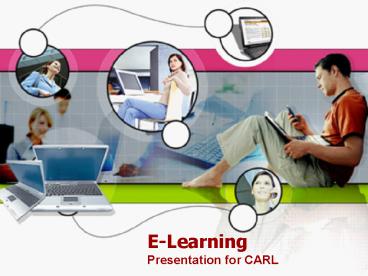ELearning - PowerPoint PPT Presentation
1 / 30
Title:
ELearning
Description:
Maintaining Quality Education While Reducing Costs: Mathematics at Wayne State University ... About Wayne State University. Located in Detroit, Michigan. Large, Urban ... – PowerPoint PPT presentation
Number of Views:41
Avg rating:3.0/5.0
Title: ELearning
1
E-Learning
- Presentation for CARL
2
Maintaining Quality Education While Reducing
Costs Mathematics at Wayne State University
3
McMaster
- Physics
- Mathematics
- Chemistry
- Biology
- Honors Science
4
About Wayne State University
- Located in Detroit, Michigan.
- Large, Urban
- Doctoral/Research University - extensive
- Over 33,000 students (growing)
5
Facing (familiar) Issues
- Rising enrollments
- Rising costs
- Reduced public funding
- Increased demands for accountability
- Changing expectations of students
6
Other issues
- Tenured faculty not interested in teaching lower
level course - Students entering courses not prepared
- Lack of facilities (classrooms)
- Inconsistency in adjuncts
- Classroom management problems
7
Question
- How do we
- accommodate growth
- improve student performance
- meet student expectations AND
- contain costs?
8
Started with Mathematics 0993
- Why math?
- Annual costs of pre-algebra mathematics in the
US 50 billion - most going to instructors
salaries. - Often required courses (retention)
- Taught by multiple adjunct faculty
- Multiple sections
- Have standard curriculum and
- Enroll large numbers of students.
9
Math 0993 at WSU
- Annual enrollment near 2000 (lots of students)
- Taught primarily by adjuncts (lots of adjuncts)
- 50 sections of 40 students each (lots of
classrooms) - General education requirement
- Pass rate 35.5 (Retention issue)
- Clearly defined learning outcomes (real numbers,
integers, basic geometry) - Tenured faculty wanted nothing to do with it
10
Roadmap to Redesign
- Mission provide expertise and support for
academic institutions interested in the
capabilities of information technology to
transform their academic institutions - focuses on the impact of projects on learning
outcomes as well as increased course-completion
rates, improved retention, student attitudes, and
satisfaction as measures of success
11
How does it do this?
- Systematic approach emphasizing
- whole course redesign,
- active learning
- individualized geared towards different learning
preferences, - time on task, and
- prompt feedback.
12
What was our process? (ADDIE)
- Stage 1 Analysis (establish campus readiness)
- Stage 2 Design (participate in redesign
workshop) - Stage 3 Development (develop the plan)
- Stage 4 Implementation (implement the redesign)
- Stage 5 Evaluation (join a community of
practice, share and assess)
13
Stage 1 Analysis (are you ready?)
- Institutions must analyze their readiness to
understake a radical tranformation - Criteria include
- Faculty able and willing to incorporate existing
materials? - Faculty have experience with integrating
computer-based instruction? - Mature information technology (IT) organization?
- Is there a recognition on the campus that
large-scale course redesign using information
technology involves a partnership among faculty,
IT staff and administrators in both planning and
execution?
14
Stage 1 Analysis (Budget)
- Course Prep
- Curriculum
- Materials
- Faculty
- Course Delivery
- Instruction
- Evaluation
15
Stage 2 Design
- Participants attend a workshop. Workhop teaches
participants how to redesign using a streamlined
process focused on - whole course redesign
- active learner-focused instruction
- use of instructional hardware and software
- mastery of specific learning objectives
- on-demand individualized assistance
- and alternate staffing models that incorporate
peer mentors and course assistants as well as
instructors.
16
Stage 2 Design
- Mathematics
- Iowa State University
- Northern Arizona University
- Rio Salado College
- Riverside CC
- University of Alabama
- University of Idaho
- Virginia Tech
17
Virginia Tech
- Mathematics grades have risen 17.4
- Failure rates have dropped 39
- Cost per student drops from 91 to 21
18
Stage 3 Develop
- Models
- supplemental model supplements traditional
lectures with computer-based resources - replacement model, replaces some lectures with
computer-mediated - emporium model, computer lab-based model,
- fully-online model, web-based environment and
- buffet model, which gives the learner the
option of choosing from any of the above, based
on their individual learning style.
19
Stage 3 Develop
- MyMathLab from Pearson Education, Inc.
- CourseCompass system (customized)
- Students pay a 35 lab fee which covers the cost.
(less than their previous textbook)
20
(No Transcript)
21
(No Transcript)
22
(No Transcript)
23
(No Transcript)
24
Stage 4 Implement
25
Stage 5 Evaluation were we successful?
26
Intermediate Algebra
- Added fall 2005.
- Same model as beginning algebra.
- About 300 students per year.
27
Results
28
Student Response
- Overall very positive.
- All like the flexibility it offers.
- Those who are able to finish the course early
love it. - The weakest students complain they want a
teacher, but dont come to the extra sessions we
offer. - Older students with poor computer skills
complain.
29
Cost Savings
- Costs dropped from 185 per student to 105 per
student. - Reduced adjuncts
- Reduced graduate students
- Large growth in enrollment
- Can now offer new courses
- Reuse classrooms for other courses
30
THANK YOU!
- ANY QUESTIONS???































